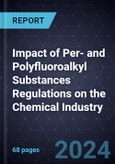Devising Strategies to Mitigate Regulatory Implications and Offering PFAS Alternatives Enable Growth Opportunities
Changing regulatory landscapes significantly impact the chemical industry’s evolution in technological advancement, product development, vertical integration, and consolidation activities.
In a recent report titled The Impact of Regulations on the Chemical Industry (PE52), we found that one of the key areas of regulation is in PFAS. These regulations will likely bring significant developments to the chemical industry as the PFAS group of chemicals has been an indispensable component of products/materials.
This study assesses the status of PFAS regulations in several regions. It also highlights current/upcoming regulations imposed on some product segments. The research team focused on 8 product segments: coatings, industrial sealants, polymer processing aids, polymeric membranes, green hydrogen economy, battery materials, F-gases, and lubricants. The analysis explores coating formulations used in various end markets and details coatings used for barrier packaging applications for paper and board and coatings on textiles.
PFAS regulations will have varying impacts on each product segment. Thus, stakeholders’ approaches to tackling PFAS regulations will also differ. The report covers the notable PFAS alternatives that will gain momentum because of these regulations in various markets and discusses how companies are replacing PFAS-based alternatives or developing PFAS-free products.
The analysis classifies these segments into products that will directly impact human health and the environment against those that will have an indirect effect to understand the implications of PFAS. It also provides a view of segments where economically and commercially viable PFAS alternatives are available versus those without. In addition, the report categorizes the types of fluorochemicals and polymers used in various applications to understand their impact on human health and the environment.
Key Features
Other important information include:
- The way for companies, industry groups, and regulatory bodies to approach PFAS regulations to achieve minimal impact on the environment without impacting the chemical industry’s growth opportunities
- Stakeholders’ actions in tackling challenges arising from these regulations
- Top PFAS alternatives across product segments
- New opportunities/potential these regulations present for chemical market segments
- New products/chemicals/materials/technologies that will gain momentum because of PFAS restrictions
Table of Contents
Companies Mentioned (Partial List)
A selection of companies mentioned in this report includes, but is not limited to:
- Nanoramic
- Solenis








